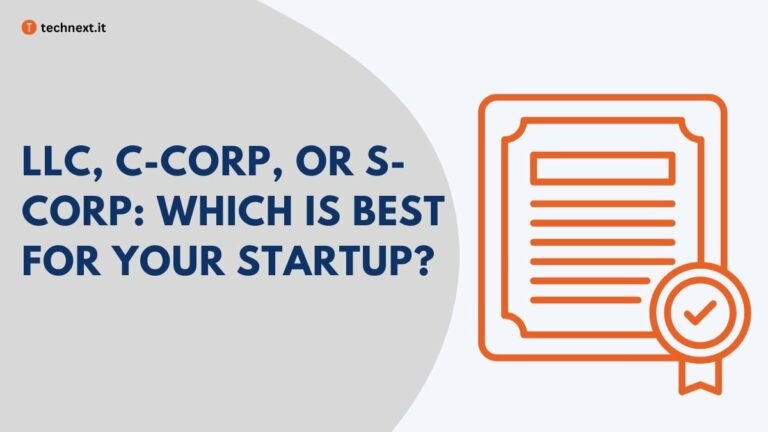What’re Your Challenges and Responsibilities as Startup CTO?
As the tech leader of a startup, you have to face unique challenges. To overcome those challenges, you will have to perform different responsibilities at different stages. Learn what those challenges and responsibilities are to stay prepared to lead the new company.

As a startup CTO, you are part of a life-changing journey and have a monumental responsibility to build, scale, and maintain the technology that brings the idea to life. From balancing the tech team to building products to bringing innovation, the role and responsibilities of a startup CTO change at different stages of the startup journey and can be both exciting and overwhelming. But this responsibility comes with a unique set of challenges.
In this blog post, we will discuss the unique challenges a startup CTO faces and explore the different stages of a startup and the specific responsibilities of a CTO at each stage. Whether you’re a CTO at a startup just starting or one that’s well-established, this post will provide valuable information on how to drive your company’s success through effective technology leadership.
Navigating the Challenges of the CTO Role in a Startup Setting
Limited Resources: Even in the era of venture funding, startups often have limited resources, including budget and staff, which can affect the CTO’s ability to implement specific technology initiatives. The CTO must be able to prioritize and make strategic decisions on allocating resources to maximize the impact of the technology team.
Rapid Growth: Although startups face resource constraints, they often manage to drive rapid growth, which can put pressure on the CTO to scale infrastructure and technology systems to meet business demands. The CTO may need to adapt to changing business needs and priorities to support the growth of the business.
Continuous Innovation: The idea of a startup is usually associated with solving a specific set of problems, and we all know that problem-solving requires innovation. That is why a culture of innovation characterizes the startup environment, and the CTO is often responsible for driving technological advancement within the company. This may involve researching and implementing new technologies and staying up-to-date on industry trends and developments.
Working with Youth: Take any startup; You will find that a large percentage of the workforce is young. This is an advantage because they are more accepting of new challenges, fast, and energetic. Yet, a CTO needs to face a different set of challenges while working with young employees. Youth is a difficult stage of life to deal with, and they are often less professional and more emotional. As a result, they often get distracted, which is detrimental to a startup environment. A CTO must be able to deal with those issues, have backup plans, and often have to make tough decisions.
Flexibility: Last but not least, the CTO must be more than just a CTO. It is a unique and demanding role that requires a wide range of skills and abilities. They must be flexible and adapt to changing business needs and priorities. This can involve various roles and responsibilities, such as leading the technical team, collaborating with other executives, managing budgets and resources, and many more.
Overall, the dynamic nature of the startup environment requires the CTO to be highly adaptable and responsive to the changing needs of the business. However, his roles and responsibilities evolve significantly with the evolution of a startup. Let’s discuss the responsibilities of a CTO at an early stage of a startup.
Startup CTO Responsibilities at Different Stages
I. Early Stage CTO Responsibilities
Building and leading a technical team
As a startup CTO, your primary concern should be to build a technical team with the right individuals. And those individuals must be capable enough to take all the challenges to make the venture profitable. The best way to build a tech team is to hire programmers you know are talented and have good values, which will help you build a tech team that works well together.
It is usually preferable for a CTO to look into your accessible areas to discover a world-class technical team capable of solving complex problems, developing innovative products, and meeting tight deadlines. When you have done building your technical team members now as a CTO, it’s your responsibility to lead to team effectively.
One of the most important steps to leading an effective technical team is to clarify your expectations of the project to the team members at the very beginning. This is important because it helps establish the standard for each team member and the team as a unit, minimizing the risk of confusion. And then, With clear expectations, you can begin setting team and project goals.
These goals give the team members something to work toward and act as a tangible reward for their efforts and an accurate measurement of their progress. Also, taking feedback from your team members from time to time is also very crucial. It helps you to access the progress of the project as well as the growth of your team members.
Besides all of these, your responsibility is to ensure the team member’s professional development. For that, you can arrange training courses, seminars, or presentations that focus on developing the team’s technical skills. By ensuring all of these above things, the technical team can flourish and grow the startup successfully.
Defining the technology strategy and roadmap
As a CTO, if the first step of building a technical team has already been completed, your next move should be to develop a technology strategy and roadmap. A clear technological strategy and roadmap can make bring a startup’s vision into reality and enable a venture into a high-performing startup. In the roadmap canvas, clear goals, objectives, obstacles, and risk analysis should be included. And each of these entities should align with the overall startup goal.
In today’s complex startup dynamics, only a few companies achieve success. These are the organizations that know how to make a clear roadmap and can accurately predict the future of the company. Making such assumptions to construct a roadmap might be challenging at times. Still, it can be made easier with the correct data, research, and, most importantly, experienced team members’ assistance.
Managing budgets and resources
Once you’ve set your goals and prepared the roadmap, infrastructure, and employees, you can start managing your detailed budget and resources. Managing the budget and resources is one of the essential tasks of the Startup as in the early stage of the Startup; most startups may need to operate with limited budgets and resources.
As a CTO, your first step should be very particular regarding where to deploy your money and resources and how your startup organization’s technology goals can be reached with the existing budget and resources. Secondly, you have to track your expenses and expenditures, from where your revenue and profit come, which resources are available, and where you can use them.
Finally, it can be said that only a well-organized and transparent management framework can accelerate the Startup’s development, and a CTO has a huge role to play in this.
Collaborating with the CEO and other executives to align technology with business goals
As a CTO, your technology leadership and goal may be well-versed, but you should still be willing to connect with your CEO and other executives of your start-up. Because you cannot dive into all aspects of your startup as an individual, you must rely on the CEO and other executives to ensure ultimate success. It is essential for you to collaborate with the CEO and other executives to align technology with overall business goals.
First, you must make your executives feel comfortable in your business meeting so that they can collaborate and contribute innovative ideas. So there’s no room to be right about your decisions. This participation can shape the goals and ideas more precisely and shift the entire team to work more effectively. The interaction between the CTO, the CEO, and the executive members should always be open, honest, and cooperative.
II. Growth Stage CTO Responsibilities
Managing the scalability of technological capacity
In the early stages of your startup, you used to have a small number of users with specific technological capabilities. However, when your startup enters the growth phase, your business is expected to explode with a large number of users.
At the same time, it is also expected to face technological challenges you haven’t met before. So, you must lead the team to scale the technical capacity to make it capable of handling the newfound challenges. And this is an essential responsibility for a CTO because every company wants to retain its users and the market share they have earned throughout the initial phases of growth.
Let’s clarify it with an example. Suppose you have an e-commerce startup experiencing rapid growth with too many orders. As a result, you may face challenges like repetitive downtime, slow loading time, etc. To address this situation, you need to scale the company’s technology capacity effectively and even hire more team members if necessary. If you don’t, you’ll lose your customer’s trust and eventually lose your users to your competitors.
Simply put, technology scalability management must be comprehensive and meticulous and is the sole responsibility of a CTO. If you want your startup to scale quickly, your technology infrastructure must scale at every stage.
Leading the transition to a more mature development process
The journey from an idea to an IPO is not a small one; depending on the industry, it often takes years. In the fast-moving tech world, it’s pretty easy to become outdated and fall behind.
Plus, at the initial stage, a startup is often subjected to limited resources. Because of that, startups tend to choose technologies that are easy to adopt instead of cutting-edge ones. On top of that, they can’t implement all the development best practices because of time limitations and employee shortages.
In the growth stage, startups overcome the problem related to limited resources. So, it is time to adopt mature technology and implement all the best practices keeping the long-term goal in mind. It is also time to establish a clear development process, introduce new technologies, focus more on QA, and many more.
And the CTO is responsible for making all those changes so that the startup becomes ready for the mature stage and beyond.
Ensuring the security and reliability of the company’s systems
As your business grows, the value of your online assets also increases. You are responsible for storing thousands, if not millions, of user data. At this stage, your company has become a more lucrative target for hackers, and cyber security becomes a real issue.
History says that most startups face data breaches during the growth phase; take Canva as an example. In 2019, they faced a data breach affecting 139 million users. The data breach exposed the user names, emails, and physical addresses, which created distrust among the users of Australia’s hottest startup.
I assume you don’t want your startup to go through the same situation, and as a CTO, it is your responsibility to protect your startup and its users from all kinds of cyber threats.
Collaborating with the sales and marketing teams to support growth
Sales and marketing are most of the time seen as separate activities. A huge mistake many companies need to realize is having their sales and marketing teams communicate with the development team, which is essential for sustainable growth. Instead, they separate themselves from other groups while trying to achieve the same goal.
In this digital marketing era, the Sales team, marketing team, and even the support team may have specific technical requirements. Let me give you a simple example, a marketing guy may need to add some tracking codes to re-target your existing customers, but they might not have the technical knowledge to do so and need tech team assistance.
But continuous requirements from other teams may disrupt the usual task of your tech team. As a CTO, it is your responsibility to set up an effective communication system between your team and those teams while maintaining the sustainable growth of the startup.
III. Maturity Stage CTO Responsibilities
Evolving the technology strategy to support the company’s long-term goals
Strategy is at the heart of all businesses and their functions, whether it’s a financial strategy, growth strategy, or marketing strategy. And technology is no different. Without a defined technology strategy, your business could be at risk. As a CTO, you can define concur strategies that align with your company’s long-term goal and support a company’s growth.
A well-developed and defined technology strategy offers many benefits to an organization and bring a huge benefit in terms of efficiency at an operational level. Suppose you align your technology strategy with your wider business objectives and implement technology solutions at the right time.
In that case, you could benefit from increased employee output, improved customer communications, and enhanced team collaboration. Also, directly linking your technology strategy with your wider business objectives enables you to ensure met overall goals of your company.
When you have entered at the maturity stage of a startup, you possess a huge set of data and experience. At this stage you should have a clear technology strategy and as a CTO you are responsible for leading the initiative.
Ensuring compliance with industry regulations
At the maturity stage, your startup will likely have a legal team to assist you with compliance and legal aspects. But not everything can be done by the legal team. The tech team needs to implement some legal aspects because they have the technical knowledge to do so.
Plus, the tech industry is continuously evolving, as are the rules and regulations. The leadership team must be aware of every new legal change and act fast to avoid lawsuits, which can potentially destroy your startup’s reputation.
To protect your startup from such disasters, the tech team must implement the required changes fast, and as a CTO, you must overlook the operation.
Take the EU cookie law as an example; now every website must declare that they are using cookies, how they use collected data etc. As a CTO, you must ensure all those necessary changes are made, and your business meets all the required compliances.
Managing relationships with external partners and vendors
Have you seen almost all big companies develop APIs and let other developers build add-ons? Why? Because when tech products are used by millions of people, thousands of new requirements arises. It is not possible for any company to build all the features and add-ons using their in-house resources.
Plus, some of your customers may need to build custom features for themselves. To fulfill these needs, you need to partner up with external vendors. As the CTO, you have to manage the partnership that relates to development.
When the partnership has been established, you must ensure alignment between the external partners and your team. And have to make sure external partners are open enough to discuss their goals, including objectives and benchmarks so that you can avoid surprises from your external partners and increase their commitment.
Besides that, it’s your prime duty to know the strengths and weaknesses of these partners. So that you can utilize each of the calibers in the right place, suppose you have one partner who is better at developing new add-on features and another partner who is better at finding new sales. So it’s always better to engage their expertise field to get the best results.
Finally, you must know when to say goodbye to your external partners; managing a partner, most often multiple partners simultaneously takes time and energy. If your external partners are not making any impact improvements to your business, it’s better to break the partnership.
Conclusion
Being a part of a startup’s leadership team, the CTO’s role is dynamic and evolves as the startup grows. The CTO is responsible for leading the technical team, building and managing the technology infrastructure and systems, and driving technological advancement. In the early stage of a startup, the CTO is responsible for building a solid technical team, developing a clear technology strategy and roadmap, and managing budgets and resources effectively.
As the startup matures, the CTO must work closely with the CEO and other executives to align technology with business goals and ensure technology decisions support the overall direction of the startup. To be successful in this role, the CTO must be adaptable, strategic, and able to lead and manage a team effectively.
I hope you liked this article and clearly understand the Roles of a CTO in a StartUp at Different Stages. You may also like the following articles.
A Complete Guide to the Ideal Tech Startup Team Structure
A Complete Guide to Ideal Startup Marketing Team Structure
How to Split Equity in a Startup Fairly in 2022
From Idea to IPO: The 5 Stages of Funding for Startups
How to Hire Developers for a Startup
A Complete Guide to the Ideal Tech Startup Team Structure
In-house Development vs Outsourcing: Guideline for Founders
Best of Luck!






